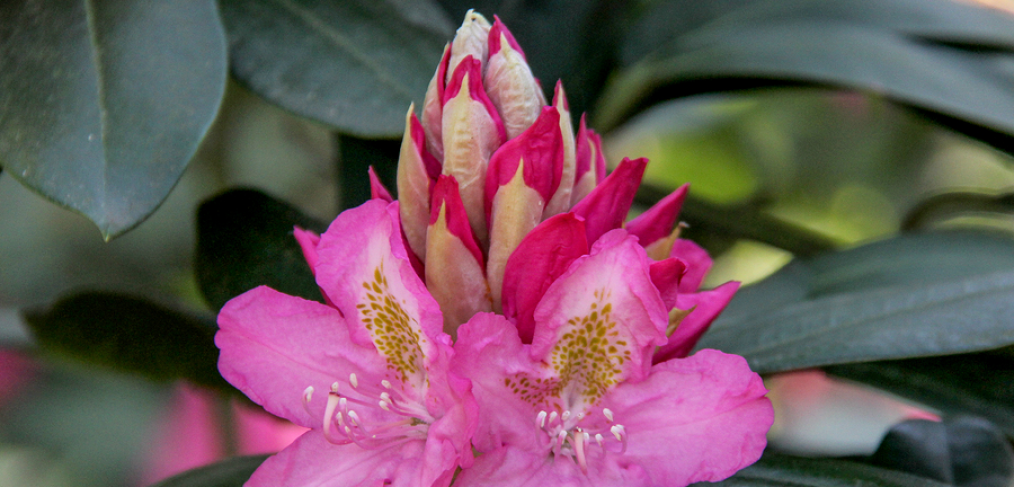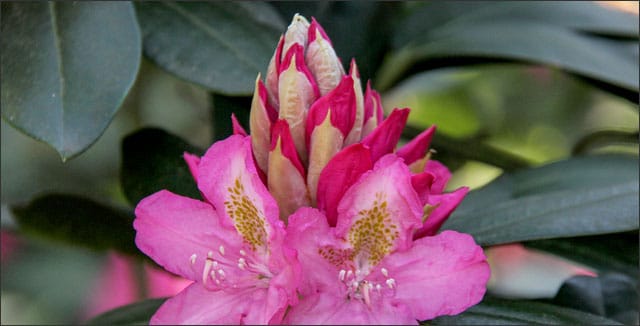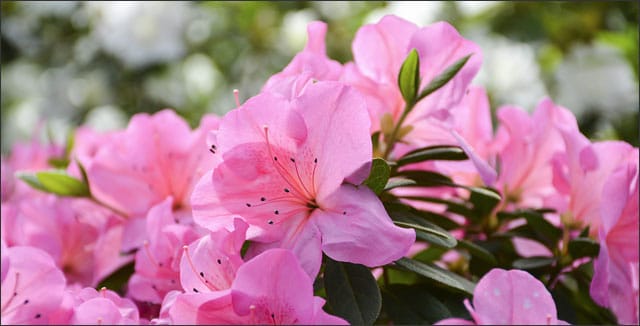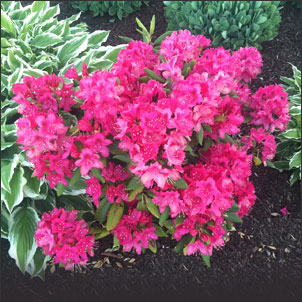
How to Easily Care for Azaleas and Rhododendrons

For years when I was growing up, my parents would move to a new house and inevitably plant an azalea or rhododendron bush. And inevitably, they would be stunted, die or not bloom properly.
My mom attributed this to the wrong quality soil, and I have since learned she was partially right. However, there are other things to consider depending on where you live. These bushes are gorgeous when healthy and in full-bloom. If you take care to plant them in the right soil and mixture of sun and shade, you can reap the benefits for many years.
If you live in the Southern United States, you probably want to have a few big old azalea bushes by your house. They are certainly popular everywhere in the U.S., but they are most popular in the southern half of this country.

Azalea blossoms
Both azaleas and rhododendrons belong to the genus Rhododendron in the Ericaceae family. This group of plants also includes mountain laurel, blueberry, and cranberry bushes. They also come in both evergreen and deciduous forms.
There are more than 800 species and 10,000 named selections. Rhododendrons generally have larger leaves and bell shaped flowers while azaleas have funnel shaped blooms and smaller leaves.
Both azaleas and rhododendrons come in a variety of colors: red, white, yellow, pink and purple. In any of those colors, you are sure to find a variety best suited for your zone.
Preparing the Soil
Here is where the most attention is needed: planting time. Both rhododendrons and azaleas need acid in their soil. They do remarkably well in partially shaded, evergreen forested areas.
Like, most plants, they need well-drained soil so if you have a flood-prone or high-clay yard, you might want to consider planting one of these shrubs in a container. They both have shallow root systems, so container gardening for azaleas and rhododendrons is an option. I’ve even heard of keeping one inside.
Root Rot
The yellow, wilting foliage my mom experienced with her azaleas was due to root rot. This can be distinguished from the yellowing due to limy, alkaline soil by the green veins in the leaves. It’s called chlorosis. This happens because of the lack of iron in the soil. Gardeners in Texas and Oklahoma may have to amend their soil in order to keep an azalea happy.
With a raised bed, keeping an azalea or rhododendron happy is a cinch. Make the bed 12-18 inches high, fill with half finely milled bark and coarse sphagnum peat moss, mix and wet thoroughly. If you’re not sure what the pH of your soil is, you can test it before you plant and add compost heavily infused with pine needles if needed. The desired pH range for an azalea or rhododendron is 5.0-6.0.
If you have heavy clay soil, try building a raised bed and mixing the top few inches of your native soil with compost. Then fill the raised bed with this mixture: 50 percent compost, 30 percent soil, 20 percent builder’s sand. This should give the plants the drainage they need while still retaining the right amount of moisture.
Keep in mind, also, that if you are watering with more alkaline water it will slowly raise the pH level in your soil. This could be an issue for anyone in arid states like Texas or Oklahoma. To combat this, you can water with a mixture of 3 parts garden sulfur to 1 part iron sulfate and apply 1 pound per 100 square foot of a garden bed. It can lower the pH by one point.
Planting Azaleas and Rhododendrons
Azaleas and rhododendrons should be planted with the top of the root ball above soil level. You should plan not to cultivate around the plant because of their shallow root systems. More important, remember that both kinds of plants absorb water through their foliage.
In dryer climates, they will need to be watered both top and bottom regularly. You can water overhead with sprinklers, but a drip systems does not work well for these plants. To prevent fungal diseases water in the morning to give the plants time to dry in the afternoon sun. To ensure that water, nutrients, and oxygen reach the root zone, install Root Starter Sticks.
Both rhododendrons and azaleas should be mulched and/or fertilized after the blooms fade in the spring. If you fertilize before they bloom, you may not get as many flowers, as the fertilizer encourages leafy growth, not flower growth. You want to find a fertilizer that is controlled-release and acid-forming.
Avoid mulching in the fall, as it may hold heat in the soil and keep the plant from going dormant. If the plant doesn’t go dormant, it will get damaged in the winter.
Sun Exposure
This can be tricky for azaleas and rhododendrons. My mom always swore by a northern exposure for these plants. It really varies according to the variety you have purchased, so be sure to discuss with a master gardener if you don’t know. But in general, northern exposure is preferred.
Eastern or northern exposures are better for azaleas and rhododendrons than western or southern exposures. In any case, most types of these shrubs will do better in the filtered sunlight beneath tall trees, or at the foundation of your house. Too much sun will bleach and burn the leaves but too little sun will result in small, stunted plants.
Pruning Azaleas
Evergreen azaleas are dense. They look nicest when symmetrical, so cutting the occasional branch is your best approach. Tip-pinch frequently after flowering ends and continues until mid-June. Deciduous azaleas should be pruned while dormant and leafless. New growth will sprout wherever you cut in the spring.
Pruning Rhododendrons

Rhododendrons
Tip-pinch rhododendrons to help them become bushier. If your plant gets leggy, prune to a side branch, leaf whorl or cluster of buds. Save your extensive pruning for late winter or early spring. It will sacrifice some flower buds but gives the plant a chance to divert its energies to latent growth buds.
Seed formation should be prevented as it reduces next year’s bloom. Clip or break off spent flower trusses without damaging the growth buds at the base of each truss.
Takeaway
Azaleas and rhododendrons are hearty, relatively disease-free shrubs that offer dense foliage and bright flowers every year. If you properly prepare their environment, you will have a gorgeous and low-maintenance plant for years to come.



